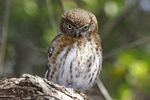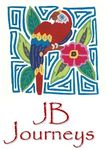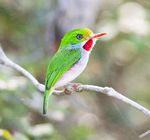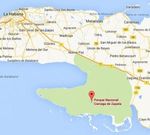Cuba Birding 2021 Nov 30- Dec 12 - JB Journeys
←
→
Page content transcription
If your browser does not render page correctly, please read the page content below
Cuba Birding 2021
Nov 30- Dec 12
with Cuban ornithologist Maikel Cañizares Morera
& JB Journeys’ Eric Stager
For more than 50 years, Cuba has been largely off the radar for US birders, but now with restrictions eased, the
island is becoming more accessible. For birders, the time is now. JB Journeys has been running fully legal tours to
Cuba since things relaxed in 2014, and we keep up with changes to verify that all regulations are followed. As of
June 2019, we are still following all new regulations and restrictions.
Cuba is the largest island in the Caribbean and supports an incredible
variety of habitat - from tropical and montane forests to extensive wetlands and
mangroves. The bird list contains somewhere just under 400 species, of which 26
are currently listed as endemic. Our itinerary may not produce a huge list, but we
have a very good chance of getting as many as 20 of the endemics, including the
world’s smallest bird, the Bee Hummingbird, the lovely Cuban Trogon, and the
adorable Cuban Tody. Our birding will be focused in the western province of Pinar
del Rio. the Zapata Swamp area, Topes de Collantes National Park, and finally the
beautiful Cuban Keys.
In addition to the opportunity to bird Cuba, we will begin with a couple of
nights in amazing and exciting Havana. In this time of great change, you really
owe it to yourself to take some time to learn about the history of the island, the
current situation, and contemplate the future through the insight of local experts.
This cannot be done without learning more of the shared history of Cuba and the US.
We have been fortunate to travel most of the island and to bird much of it ourselves, and we are pleased
to offer this exciting itinerary under the guidance of one of the best birders in Cuba, Maikel Cañizares Morera.
JB Journeys’ own Eric Stager will escort the group and assist Maikel.
NOV 30 - Tuesday (Day 1) - arrive Havana (D)
On flight arrival you will be met by our local host and driven to your casa particular in Havana for 2 nights.
Casas Particulares are similar to what we call a Bed & Breakfast. In 1997, the Cuban government allowed
Cubans to rent out rooms in their houses or apartments to tourists, providing Cuban families with new
sources of income, and offer you, the visitor, the chance to see what life is like in a Cuban home. Many
families have added rooms to their homes for this purpose, almost like a small hotel. Depending on group
size, we may be housed in a couple of casas. All rooms in casas that we use will have private bath with hot
water.
Once the group settles in, we’ll meet up again for dinner in a local paladar.
Paladares (from the Spanish word for palate) are private restaurants in people's homes, and like casas
particualres, they represent the new entrepreneurship growing among Cubans as they find an opening
within the economy at large, as well as introducing new and exciting food. Over the few decades, Havana
has transformed itself from a food desert to one of the most exciting foodie experiences around. More than
2,000 paladares have opened in Havana alone, adding greatly to private sector jobs. While many are still in
private homes, a number are stand alone in public buildings.
www.jbjourneys.com T:512.217.4814 jbjourneys@yahoo.comDEC 1 – Wednesday (Day 2) – Old Havana / New Havana (B,L)
This morning we’ll begin with a guided walking tour of Old Havana, which was declared a UNESCO World Heritage
Site in 1982. Habana Vieja is a living museum, filled with over 3,000 buildings in varying stages of renovation.
The old colonial city boasts several squares of historic significance. Plaza Cathedral is dominated by the 18th
century Cathedral of Havana. Plaza de Armas is the oldest square, used for military exercises by the Spanish
from the 16th century. The Palacio de los Capitanes Generales on the western side of the square was the seat of
Spanish authority, then became the headquarters of US military governors, and finally the presidential palace
after the Republic of Cuba was born in 1902. Plaza San Francisco (1628) was once the commerce hub, where
Spanish galleons came for supplies for their transatlantic journeys. The former Basilica de San Francisco is today
a concert hall. Plaza Vieja was established in the 16th century as a market square and remained so until 1835.
After lunch in a local restaurant, this afternoon we’ll see a bit of Modern Havana - or should we say Mid-
Century Modern? We’ll cruise around the Vedado neighborhood, maybe stop at the Hotel Nacional, famous as
a hangout for gangsters and mafia figures.
Dinner on your own tonight – try something new! If interested in seeing a show at the legendary
Tropicana, we can arrange that at an addition cost.
DEC 2 – Thursday (Day 3) – Habana to Viñales (B,L,D)
After breakfast, we depart for Viñales, Pinar del Rio province.
The drive is about 200 km (124 miles), but we’ll make birding
and comfort stops along the way, starting at Las Terrazas, a
UNESCO designated Biosphere Reserve. We’ll continue to
Viñales where we will spend two nights in in a local hotel or
Casa of the region
Viñales is situated in Sierra de los Organos and is a
delightful small town in a beautiful valley with a
distinctive landscape of steep-sided limestone “mogotes.” About 100 bird species have been reported from
the area. Target species: Cuban Grassquit, Cuban Solitaire, and Olive-capped warbler. (endemics will be
listed in bold) Pinar del Rio is also known as the place where the best tobacco is grown.
In the afternoon we’ll bird near the mogotes, the unique karstic formations in Viñales. The Cuban Solitaire,
Olive-capped Warbler, Cuban Trogon and Cuban Tody may appear. On our way, we may have time to visit a
local tobacco farm and see the tobacco drying sheds.
Overnight casa in Vinales
DEC 3 – Friday (Day 4) Full day in Viñales. (B,L,D)
Las Maravillas is by far the most important trail in Viñales area. Our target species here is the Cuban Solitaire,
but there we also can see the Olive-capped Warbler (the Cuba-and-Bahamas warbler), Western Spindalis, the
lovely Cuban Trogon, Cuban Tody, Cuban Pygmy Owl, Cuban Vireo, and Red-legged Honeycrepper. Besides this
list, Maravillas is home to many warblers and more common birds like Yellow-faced Grasquit, Northern
Mockingbird, Cuban Blackbird, White-crowned and Scaly-napped pigeons.
Depending on his schedule, we hope to visit to the studio of Nils Navarro. Nils is author
and illustrator of ENDEMIC BIRDS OF CUBA - A Comprehensive Field Guide, which
features illustrations as well as photographs and provides detailed and invaluable
information describing habitat, distribution, behavior, and physical characteristics of
Cuba’s 26 endemic birds, and another 22 species endemic to the West Indies.
Overnight casa in Viñales
DEC 4 – Saturday (Day 5) – Vinales to Zapata Peninsula . (B,L,D)
After breakfast, we will depart for Playa Larga on the Zapata Peninsula, in total about 5 hours drive with comfort
stops and maybe some birding along the way.
www.jbjourneys.com T:512.217.4814 jbjourneys@yahoo.comThe Zapata Peninsula has always been a sparsely populated area of
Cuba, so it was possible for the Cuban government to create the Zapata
Peninsula National Park. It was declared a world biosphere reserve in 2000
and a Ramsar site in 2001. The park covers an area of over 1,930 square
miles and is the largest, best-preserved wetlands in the Caribbean islands.
It is a regional, national, and world natural preserve, with fragile
ecosystems and important natural resources.
The vast majority of Cuba's birds can be found on Zapata
throughout the year, including many of the current 26 endemics. Among
the birds you may see are Wood Stork, American Flamingo, Magnificent
Frigatebird, Green Heron, Little Blue Heron, Neotropical Cormorant, Great
Blue Heron, Brown Pelican, Northern Jacana, Cuban Black-Hawk, Grey-fronted Quail-Dove, Blue-headed Quail-
Dove, Key West Quail-Dove, Zenaida Dove, Cuban Lizard-cuckoo, Smooth-billed Ani, Bare-legged Owl, Cuban
Pygmy-Owl, Stygian Owl, Cuban Nightjar, Bee Hummingbird (the world's smallest
bird!), Emerald Hummingbird, Cuban Trogon, Cuban Tody, West Indian Woodpecker,
Fernandina's Flicker, Cuban Green Woodpecker, Cuban Parakeet, Cuban Parrot,
Cuban Peewee, La Sagra's Flycatcher, Loggerhead Kingbird, Cuban Vireo, Yellow-
throated Vireo, Striped-headed Tanager, Cuban Crow, Zapata Wren, Cuban
Gnatcatcher, Cuban Solitaire, Red-Legged Thrush, American Redstart, Black-and-
white Warbler, Palm Warbler, Yellow-headed Warbler, Cuban Bullfinch, Zapata
Sparrow, Red-shouldered Blackbird, Cuban Blackbird, Greater Antillean Grackle,
and Cuban Oriole.
The bay here is Bahía de Cochinos, but you may know it from history
as the Bay of Pigs. A small museum in Playa Girón tells the story of the Bay
of Pigs invasion from the local perspective, and billboards and monuments
in the area mark significant sites. The museum is certainly worth a visit.
In Playa Larga, we will stay in local Casas Particulares for 3 nights. These
are small towns with a welcoming feel and they are dependent on tourism.
Overnight casa in Playa Larga
DEC 5/6 – Sunday/Monday (Days 6/7) . (B,L,D)
With Playa Larga as our base, we will spend the next two days exploring scrub, mangrove swamp, and coastline
in some of these areas:
• La Turba (30-minute drive) a marsh habitat, where we will be looking for Zapata Wren, Zapata
Sparrow, and Red-shouldered Blackbird.
• Las Salinas Refuge (30-minute drive, flat, dry dirt roadway). Habitat is varied
among low, dense forest, mangrove, marsh, and open wetlands. Here we are
likely to encounter the endemic Cuban Black Hawk as well as numerous wading
birds like American Flamingo, Roseate Spoonbill, White Ibis, Reddish Egret, and
various ducks and shorebirds.
• Sopillar - target species: endemic quail-doves and owls. We will also be looking
for Nearctic migrants, such as Swainson’s Warbler and Worm-eating Warbler.
• Los Sábalos - for the exclusive quail doves like Grey-headed Quail-dove, Ruddy
Quail-Dove, Gray-fronted Quail-Dove, and Key West Quail-Dove.
• One evening, we can head out to look for the b and the nocturnal raptors: Stygian Owl; Cuban Pygmy-
Owl and Bare-legged Owl.
Overnight casa in Playa Larga
www.jbjourneys.com T:512.217.4814 jbjourneys@yahoo.comDEC 7 – Tuesday (Day 8) Playa Larga to Topes de Collantes . (B,L,D)
This morning, we’ll leave Zapata after birding Bermejas, a wildlife refuge with national significance, an open
area with royal and cabbage palms, brush, and shrubbery, and flat, easy walking trails. Excellent chance here for
the Bee Hummingbird, Fernandina’s Flicker, Blue-Headed, Grey-fronted, Key West and Ruddy quail-doves,
Cuban Parrot and the threatened Cuban Parakeet. Cuban Blackbird, Cuban Bullfinch, Loggerhead Kingbird,
Bare-legged Owl, and Cuban Pygmy-Owl are also likely.
In the afternoon, we’ll continue the trip to Topes de Collantes, one of
Cuba’s most beautiful areas, an extraordinary
natural landscape of 200 square kilometers
within the Guamuahaya mountain range. This
area features imposing peaks, lush valleys,
exuberant vegetation, unique flora and fauna,
cave systems, beautiful vistas, and pure,
transparent rivers and streams that form natural
falls and pools. And, of course, there are fantastic forest birds, including the iconic Cuban Trogan and Cuban
Tody. The drive is 150 miles and should take about 3 hours.
Overnight at Los Helechos Hotel or similar
DEC 8 – Wednesday (Day 9) Topes de Collantes (B,L,D)
In the morning you will visit Guanayara Park and we will walk through Centinelas del Rio Melodioso, a fairly easy
round-trip hike of about 4 miles. The trail begins in cool, moist coffee plantations and descends to the stunning
El Rocio waterfall. The microclimate in Topes makes it possible to see more than 100 species of birds, including
many of the endemics, such as the Cuban Tody and the Cuban Trogon.
Overnight at Los Helechos Hotel or similar
DEC 9 – Thursday (Day 10) Topes to Cayo Coco . (B,L,D)
Before heading to the beautiful Cayo Coco, we’ll make a stop at Tunas de Zaza to have a typical Cuban lunch
and observe some of the local species. We should have excellent views of the Greater Flamingo and some
shore birds. The drive is about 160 miles and should take about 4 hours, but we should see many water birds
on the way to Cayo Coco.
Overnight Melia Cayo Coco or similar
DEC 10 – Friday (Day 11) Los Cayos (B,L,D)
Cayo Coco and nearby offshore keys on the northern (Atlantic) coast provide great
habitat for a diversity of waterbird species, including the West Indian Whistling-Duck,
migrants, and restricted-range and endemic subspecies. Since 1988, Cayo Coco has
been connected to the mainland by a 17-mile, causeway. The islands offer pristine
white-sand beaches, mangrove flats, low coastal scrub and crystal clear waters;
however, the area is being rapidly developed for “sun and sand” tourism and the
habitat of many important species may become threatened.
Cayo Paredón Grande, the most northeastern key in the archipelago and is one
of Cuba’s important migratory landfalls. You will search for the Bahama Mockingbird,
Cuban Gnatcatcher, Oriente Warbler, Gundlach’s Hawk, Scaly–naped Pigeon, and
Mangrove Cuckoo. Thick-billed Vireo and a subspecies of Zapata Sparrow are also target birds for the
archipelago.
In the afternoon, we visit Cayo Guillermo area to look for the Thick-billed Vireo and Bahama's
Mockingbird as well as shorebirds in lagoons and marshes on the way.
Overnight Melia Cayo Coco or similar
www.jbjourneys.com T:512.217.4814 jbjourneys@yahoo.comDEC 11 – Saturday (Day 12) Return to Havana (B,L,D)
This morning we’ll visit Cueva de los Jabalíes, a great place to spot Key West Quail-Dove, Zenaida Dove, Cuban
Tody, Oriente Warbler, La Sagra’s Flycatcher, Red-legged Honeycreeper and any migratory warblers hanging
around. We will look for Zapata Sparrow in a very different habitat from Zapata.
Then we head back to Havana, a drive of about 350 miles, around 7 hours. After checking into the hotel
or casa and a short time to freshen up, we will have a final dinner together in one of Havana's fine private
restaurants.
Overnight at a casa or hotel in Havana
DEC 12 – Sunday (Day 13) – Adios Havana (B)
Departure from the hotel will be about three hours before flights to allow sufficient time for check in.
NOTE: The order and sites visited may vary due to weather, road conditions, and other factors beyond our control.
About your guides:
Maikel Cañizares Morera, MSc. is a Ph.D. candidate in a joint program between
Universidad de la Habana, Cuba, and Universidad de Alicante, Spain working on his
dissertation, “Breeding ecology and conservation of Cuban Parakeet (Aratinga
euops).” Much of what is known about Cuban Parakeets in the wild comes from
Maikel’s research.
Maikel worked on conservation projects in protected area of Lomas de Banao in
Central Cuba. While there, he completed his Master's degree in Ecological Studies on
the Conga hutia, a species of rodent endemic to Cuba. He has designed and
implemented different models of nesting boxes for parrots that are successfully used in various Cuban locations
and has collaborated with other conservation projects in Panamá, Nicaragua, and the Dominican Republic. His
work has always been linked to local communities, aware that they are a key element in biodiversity
conservation.
Currently, he is a researcher at the Institute of Ecology and Systematics (IES) in Havana and specializes in
ecology, management, and conservation of forest birds, with emphasis on the conservation and management of
Cuban psittacines. He is a scientific advisor at the National Forestry Directorate for Cuban Wildlife Policy and is
past President of the Cuban Society of Zoology. He has published more than 16 papers on these topics, is chapter
author of six books, and has attended 45 national and international congresses. He has organized events in his
own country including the XVII Congress of the Mesoamerican Society for Biology and Conservation (MSBC) in
Havana in 2013 and the XXI Conference of BirdsCaribbean in Topes de Collantes in 2017.
Maikel is also a member of the Cuban Botany Society, was the president of the Cuban Chapter of the MSBC
from 2007-2017, and currently serves on the board of BirdsCaribbean.
He has great skills in the field as a birding guide, managing logistics and preparing for field and survival
expeditions. Maikel is a native Spanish speaker and is fluent in English. And he’s a lot of fun!!
Eric Stager grew up on the Upper Texas Coast where he was bitten by the birding bug in 1981 at the age of 13.
Although detrimental to his teenage social life, his obsession with birds was spurred on by kind mentors and
nourished by the excitement of growing up in one of North America’s top birding locations.
While still in high school, Eric was leading field trips for the local bird club, compiling his
local Christmas Bird Count, and operating the Texas Coast Rare Bird Alert (in the days of
cassette tape answering machines). Eric left the coast to attend the University of Texas and
has lived in Austin ever since. He has expanded his sights with birding trips in South
America, Africa, Asia and Australia. In Austin, Eric leads field trips and teaches birding
classes for Travis Audubon Society, and also serves as president of the board of directors.
He works as a Senior Environmental Scientist for the City of Austin, Texas.
www.jbjourneys.com T:512.217.4814 jbjourneys@yahoo.comCuba Birding 2021 - Nov 30- Dec 12
• Cost $4795 per person in double room with 10. With 8: $4895; with 6: $5195.
• Single supplement $425 (very limited) (singles are either a double on your own, or a smaller room for one person)
• Minimum 6; maximum 12.
• To confirm your spot, please compete this reservation form. Deposit is $500 per person and final payment
will be due August 30, 2021.
• Cancellation: After 30 days, deposit is non-refundable. Up to 90 days prior to departure, 50% refundable.
Inside 90 days, non-refundable. Name change may be allowed. There is no refund for unused tour parts
of the tour
Included: Not Included:
• Airport transfers on arrival/departure days only • Airfare
• Local transportation by A/C bus or van, • Visa**
depending on group size • Meals not listed
• 12 nights lodging with taxes • Drinks during meals
• Excursions as listed with any entry fees • Gratuities to local guide (suggested $10-15/day
• Meals as listed per person)
• Basic gratuities for group lunches and dinners • Gratuities to lodging (suggested $3-5/day per
• Basic gratuities for van/bus driver room)
• Bilingual birding guide • Gratuities for breakfasts (suggested $1-2/day)
• Escorted by JB Journeys’ Eric Stager • Comprehensive travel insurance*
• Cuban medical insurance*
NOTE TO PHOTOGRAPHERS: The purpose of this tour is to see as many of Cuba’s birds as possible,
especially the endemics and other rare species. We love having good photos of the birds and the trip and
we welcome you to bring your camera.
This is not a trip for learning bird photography. If that is your goal, we are happy to connect you with
companies who specialize in bird and wildlife photo tours.
*Cuban medical insurance covers many needs but is not inclusive. For example, medical evacuation is not
included. We recommend comprehensive travel insurance coverage and are happy to make suggestions
as to companies offering coverage for travelers in Cuba. Like everything else regards travel in Cuba, it’s a
whole other story.
** Visas to visit the island are required. Your airline may offer this service to you. If you want us to obtain
your visa, the cost is US $100 per person (subject to change). This is our cost with no mark-up.
www.jbjourneys.com T:512.217.4814 jbjourneys@yahoo.comYou can also read



























































